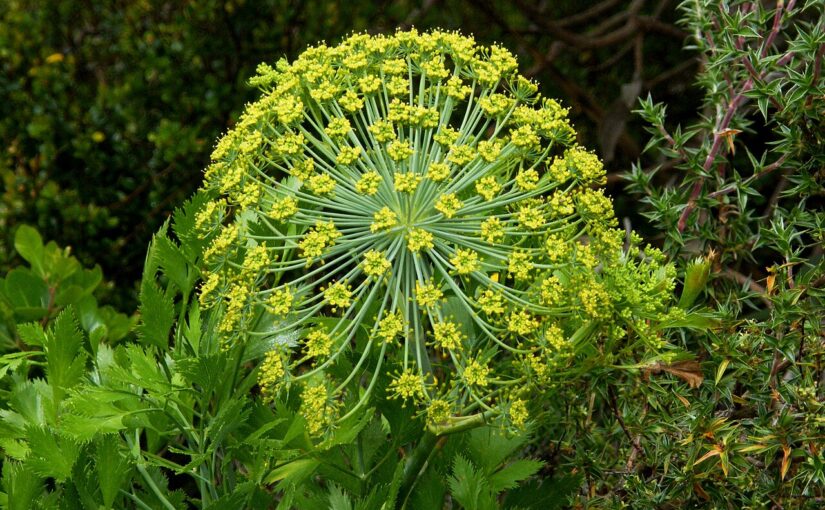Galbanum essential oil traces its roots to the rugged slopes of northern Iran and the broader landscapes of western Asia and the Middle East. Known scientifically as Ferula gummosa, this plant is a member of the Apiaceae family, thriving in demanding mountainous and desert climates. The resin, a milky sap exuded from incisions in the stems and roots, gradually hardens into waxy “tears” and is then steam-distilled to produce a clear to yellow or olive-tinted oil. With an aroma described as fresh, green, and earthy, galbanum presents both woody depth and an intriguing complex of metallic and spicy notes, all topped with a distinctive balsamic brightness. Its scent has a top note quality, offering immediate impact and lingering intrigue.
Sacred Roots and Historical Reverence
Galbanum’s legacy stretches deep into antiquity. Highly prized in ancient Greek and Roman times, the gum resin once formed a cornerstone of sacred incense used in rituals and healing ceremonies. Its fragrant “tears” traveled the ancient trading routes, finding their way into medicinal balms, skin treatments, and perfumes across the Middle East. The green-woody aroma was not simply valued for its pleasing quality but also for its grounding effect. Used in temples and private rituals, galbanum symbolized both serenity and subtle power, linking the sacred with the physical world. Today, the same qualities that saw it celebrated in ancient rites now make galbanum oil a fixture in modern perfumery and aromatherapy.
Therapeutic Benefits in Modern Wellness
Galbanum essential oil brings a comprehensive set of healing actions. As an anti-inflammatory and analgesic, it provides relief for aching joints, muscular pain, and discomfort from menstrual cramps. Its antispasmodic ability addresses muscle and bronchial spasms, making it useful for asthmatic coughs or respiratory tension. With notable antimicrobial and antiseptic effects, galbanum is known to speed the healing of abscesses, boils, acne, and wounds, reducing scarring and protecting against infection.
For respiratory wellness, galbanum shines as an expectorant and decongestant, helping to clear chronic congestion, colds, flu, catarrh, and stubborn mucus in bronchitis or asthma. On mature or troubled skin, its astringent and skin-healing properties provide a gentle toning action, soothe psoriasis, and refine the complexion. As a detoxifying agent, the oil assists in eliminating uric acid and supporting improved blood circulation, which is vital for those with arthritis. Its sharp aroma is also a natural repellent for insects such as mosquitoes and bedbugs.
Aromatherapy and Everyday Uses
Galbanum’s versatility in aromatherapy makes it suitable for a range of applications. In a diffuser, just a few drops can calm frayed nerves, freshen the environment, and help deter insects. Its intense aroma lends itself well to blends, often tempered by the addition of lavender for a softer balance. For topical use, dilute galbanum oil in a carrier oil, such as avocado enriched with vitamin E, to massage into sore muscles or aching joints, or to aid in the healing of wounds and persistent acne.
It is also effective in homemade salves or creams for managing scars, supporting mature skin, and soothing psoriasis. When used as an air spray, galbanum infuses rooms with an earthy freshness while acting as a natural insect barrier. A small dose inhaled from a tissue can ease anxiety or clear the head during respiratory discomfort.
Emotional and Energetic Influence
Beyond the physical, galbanum’s green aroma delivers a powerful emotional balance. It is both a sedative and a stimulant, unique in its ability to calm anxiety and depression while gently invigorating the senses. Its constituents are said to harmonize mood swings, soothe nervous tension, and restore equilibrium, benefits especially valued during premenstrual or menopausal transitions. Spiritually, galbanum is linked to the solar plexus and heart chakras, offering earth and metal energy that grounds and revitalizes. Many find it ideal for meditation, stress relief, and practices that call for a centering presence.
Blending and Pairing Possibilities
Galbanum oil’s profile pairs beautifully with other aromas, offering depth and support in blends. Frankincense, geranium, jasmine, lavender, pine, rose, and ylang-ylang all harmonize well, creating sweet and complex olfactory experiences. For those seeking a substitute, myrrh or frankincense can mirror some of its resinous, skin-healing aspects, although without galbanum’s notable green signature.
Safe and Sustainable Use
Attention to safety ensures a positive experience with galbanum. The oil’s potency means it should always be diluted to one percent for skin applications and patch-tested beforehand. Undiluted or oxidized oil may irritate, so freshness is key. Add synthetic antioxidants if possible, and store in a dark glass bottle in a cool, dark location. Those who are pregnant should avoid galbanum due to potential hormonal effects and anyone considering ingestion should consult a professional.
The Earthy Embrace of Galbanum
Galbanum essential oil is an invitation to balance, rooted in ancient tradition and modern practice alike. Imagine the resin slowly seeping from a rugged Iranian hillside, then distilled into an elixir of green calm and rooty strength. Whether massaged into sore joints, diffused for relaxation, or added to a skincare blend, galbanum is both an anchor and a beacon. It grounds the nervous system, clears the lungs, revives the skin, and centers the spirit. A testament to the enduring wisdom of natural remedies from the heart of the Middle East.
Image by Andrew Massyn.
